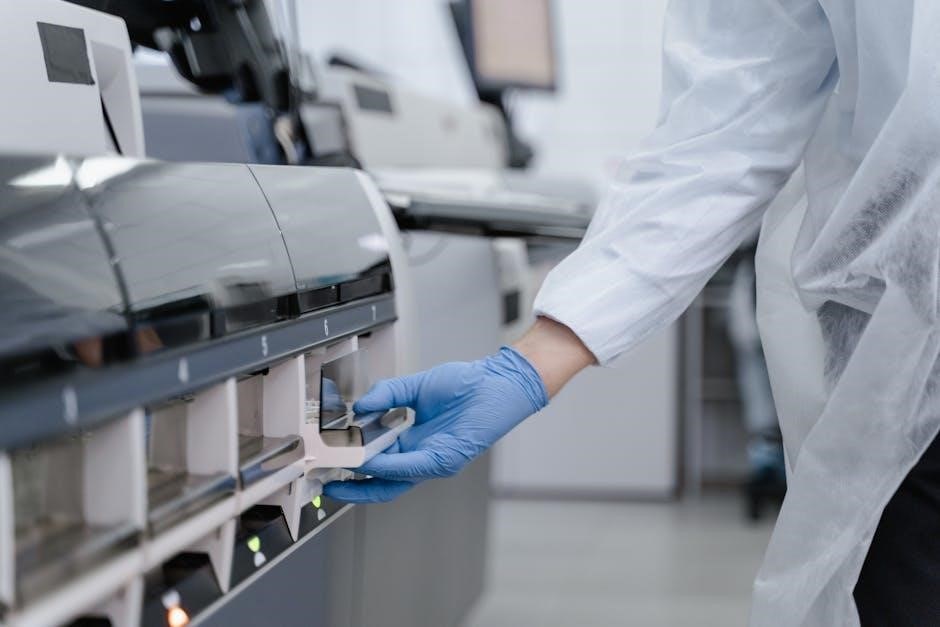Understanding the Body, Soul, and Spirit in the Bible
The Bible teaches humans are composed of three interconnected parts: body, soul, and spirit, each serving unique roles․ This triune nature reflects God’s design, enabling us to interact with the physical world, experience emotions, and connect with the divine․ 1 Thessalonians 5:23 highlights this unity, praying for the complete sanctification of all three parts․ Understanding this framework helps believers live a balanced, God-centered life, fostering harmony between their physical, emotional, and spiritual beings․
The Bible introduces humanity as a triune being, comprising body, soul, and spirit․ This threefold nature reflects God’s intentional design, enabling humans to engage with the physical world, experience emotions and thoughts, and connect with the divine․ The body serves as the physical vessel, while the soul encompasses emotions, personality, and consciousness․ The spirit, the deepest part, facilitates communion with God․ This interconnected framework is vital for understanding human existence and relationship with God․ The harmony between these elements is essential for holistic living, as expressed in 1 Thessalonians 5:23, which prays for the complete sanctification of spirit, soul, and body․ This triune understanding provides a foundation for personal growth, worship, and spiritual maturity, emphasizing the importance of balancing all aspects of human nature․
The Biblical Basis for Body, Soul, and Spirit
The Bible provides a clear foundation for understanding the triune nature of humanity, comprising body, soul, and spirit․ In Genesis 2:7, God formed man from dust and breathed life into him, creating a living soul․ The soul is the essence of human life, encompassing emotions, will, and consciousness․ The spirit, as seen in Zechariah 12:1, is the immortal part that connects humanity to God․ The body, while physical, is also sacred, as stated in 1 Corinthians 6:19-20, where it is called the temple of the Holy Spirit; These distinctions are further clarified in Hebrews 4:12, which separates the soul and spirit, and Matthew 22:37, emphasizing the heart (soul) and spirit in loving God․ This biblical framework establishes the interconnected yet distinct nature of body, soul, and spirit, essential for spiritual understanding and growth․

The Biblical Perspective on the Body
The Bible views the body as a sacred temple of the Holy Spirit, essential for worship and service․ It emphasizes caring for the body as an act of stewardship and honoring God․
The Body as the Temple of God
The Bible teaches that the human body is the temple of the Holy Spirit, emphasizing its sacredness and purpose․ In 1 Corinthians 6:19-20, Paul writes, “Do you not know that your bodies are temples of the Holy Spirit, who is in you, whom you have received from God? You are not your own; you were bought at a price․ Therefore, honor God with your bodies․” This highlights the body’s role as a dwelling place for God’s Spirit, making it a vessel for worship and service․ The concept underscores the importance of living a life that honors God, avoiding defilement, and pursuing holiness․ Caring for the body is not just a physical act but a spiritual one, reflecting reverence for God’s presence within․ This teaching calls believers to view their bodies as sacred and to use them for God’s glory․
- The body is a temple, requiring respect and care;
- Living a holy life is essential to honoring God․
- The Holy Spirit’s presence calls for stewardship of the body․
The Role of the Body in Worship and Service
The body plays a vital role in worship and service, as it is the physical vessel through which believers express their devotion to God and minister to others․ In Romans 12:1, Paul urges believers to present their bodies as a living sacrifice, holy and acceptable to God, which is their spiritual worship․ This emphasizes that worship is not limited to spiritual acts but involves the body as well․ The body is used in acts of service, such as helping the needy, preaching the gospel, and engaging in physical labor for God’s kingdom․ By caring for and using the body responsibly, believers honor God and fulfill their purpose in His plan․ Thus, the body is both a tool for worship and a means of serving God and humanity․
- The body is integral to expressing worship and service․
- Physical actions can be acts of spiritual worship․
- Service to others is a form of bodily worship․
Biblical Verses Emphasizing the Importance of the Body

The Bible highlights the significance of the body through various verses, reinforcing its role in God’s plan․ In 1 Corinthians 6:19-20, Paul states that the body is the temple of the Holy Spirit, emphasizing its sacredness and the need to honor God with it․ Romans 12:1 urges believers to offer their bodies as living sacrifices, aligning physical actions with spiritual devotion․ Psalm 139:14 celebrates the body as fearfully and wonderfully made, reflecting God’s craftsmanship․ Additionally, 1 Corinthians 15:42-44 speaks of the body’s future glorification, proving its eternal significance․ These verses underscore the body’s value and encourage believers to use it for God’s glory․
- 1 Corinthians 6:19-20: The body as God’s temple․
- Romans 12:1: Offering the body as a living sacrifice․
- Psalm 139:14: The body as a divine creation․
- 1 Corinthians 15:42-44: The future glorification of the body․
Exploring the Soul in Scripture
The soul is portrayed in Scripture as the essence of human emotions, thoughts, and personal identity, connecting humanity to the divine and reflecting its eternal nature․

The Soul as the Essence of Human Emotions and Thoughts
The soul is biblically depicted as the core of human emotions, desires, and thoughts, distinguishing it from the physical body and spiritual aspects of human nature․
Genesis 2:7 highlights the soul as the life-giving breath from God, animating the body and enabling consciousness, emotions, and mental processes․ The soul is where joy, sorrow, love, and grief reside, as seen in Psalm 42:6, which expresses deep emotional longing․ It is also the seat of rational thought and decision-making, as Proverbs 23:7 emphasizes the power of thoughts in shaping identity․ The soul’s emotional and intellectual dimensions are inseparable, reflecting humanity’s unique capacity for relationship with God and others․ This understanding is vital for grasping the holistic nature of human existence and the interconnectedness of body, soul, and spirit in biblical teaching․
The Soul’s Connection to Personal Identity and Personality
The soul is deeply intertwined with personal identity and personality, serving as the essence of who we are beyond the physical body and spiritual dimensions․
In Scripture, the soul is often linked to individuality, encompassing traits like character, memories, and moral choices․ For example, 1 Peter 3:3-4 emphasizes the inward beauty of the soul, reflecting a person’s true identity․ Personality traits, such as kindness, wisdom, or courage, are expressions of the soul’s uniqueness․ The soul also carries the weight of personal accountability, as it is the part of humanity that stands before God in judgment (Hebrews 4:12)․ Understanding the soul’s role in shaping identity helps believers grasp their value to God and their purpose in His plan․ This connection underscores the importance of nurturing the soul for spiritual growth and wholeness․
Biblical Teachings on the Eternal Nature of the Soul
The Bible teaches that the soul is eternal, continuing beyond the physical death of the body․ In Matthew 22:37, Jesus emphasizes loving God with all one’s soul, highlighting its enduring significance․ The soul’s immortality is reaffirmed in Ecclesiastes 12:7, which states that the spirit returns to God who gave it․ This eternal nature is also reflected in 1 Peter 1:22-23, where souls are described as purified and born again through the Word of God․ The soul’s destiny is tied to its relationship with God, either in eternal life with Him or separation from Him (Luke 12:20)․ Understanding the soul’s eternity underscores the importance of spiritual decisions and the hope of eternal life through Christ․ This teaching provides comfort and motivation for believers to prioritize spiritual growth and eternal values․ The soul’s eternal nature is a cornerstone of biblical theology and personal faith․
The Spirit in Biblical Context
The Spirit represents the divine connection to God, empowering believers for spiritual growth, guidance, and fellowship․ It embodies God’s presence and active work in transforming lives and glorifying Christ․
Scripture highlights the Spirit’s role in regeneration, sanctification, and empowerment, making it central to the Christian life and relationship with God․ The Spirit’s ministry is essential for understanding spiritual truth and living a life pleasing to God․
The Spirit as the Divine Connection to God
The Spirit is often depicted in the Bible as the divine connection to God, serving as the bridge between humanity and the divine․ It is through the Spirit that individuals experience God’s presence and guidance․ In the body-soul-spirit diagram, the Spirit is typically illustrated as the highest or most sacred component, symbolizing its role in facilitating communication and relationship with God․ This concept is central to understanding spiritual growth and intimacy with the divine․ The Spirit’s connection to God is emphasized in various biblical teachings, highlighting its essential role in worship, prayer, and spiritual transformation․ By examining the Spirit’s function, believers gain deeper insights into how to nurture and strengthen this vital connection․
The Role of the Holy Spirit in Spiritual Growth
The Holy Spirit plays a pivotal role in spiritual growth, enabling believers to deepen their relationship with God․ Through conviction, the Spirit brings awareness of sin, prompting repentance and transformation․ Sanctification, a lifelong process, is empowered by the Spirit, helping believers live according to God’s will․ The Spirit also imparts spiritual gifts, equipping individuals for ministry and service․ Furthermore, the Spirit seals believers, guaranteeing their eternal inheritance in Christ․ This divine empowerment fosters maturity, enabling believers to bear fruit such as love, joy, and peace․ The body-soul-spirit diagram highlights the Spirit’s central role in nurturing spiritual life, emphasizing the need to rely on His guidance and strength for holistic growth․ Understanding this role is essential for fostering a vibrant, Spirit-led life․
Biblical References to the Spirit’s Function in Believers
The Bible provides clear references to the Spirit’s function in believers, emphasizing empowerment, transformation, and divine connection․ In Romans 8:11, the Spirit is described as giving life to believers’ mortal bodies, highlighting physical and spiritual renewal․ 1 Corinthians 6:19-20 underscores the Spirit’s indwelling presence, calling believers to honor God with their bodies․ Galatians 5:22-23 lists the fruit of the Spirit, such as love, joy, and peace, as evidence of His work in believers’ lives․ Ephesians 1:13-14 refers to the Spirit as a seal and pledge of believers’ inheritance, ensuring eternal security․ These verses illustrate the Spirit’s role in integrating the body, soul, and spirit, enabling believers to live a God-centered life․ The body-soul-spirit diagram aligns with these teachings, visually representing the Spirit’s transformative and unifying work in believers․

Interconnection of Body, Soul, and Spirit
The body, soul, and spirit are intricately connected, each influencing the others in daily life, emphasizing the importance of holistic well-being according to biblical teachings․
The Trinity of Human Existence
The Bible portrays humanity as a trinity of body, soul, and spirit, reflecting God’s triune nature․ This interconnectedness emphasizes that humans are more than physical beings; they are spiritual and emotional entities․ The body serves as the physical vessel, the soul as the seat of emotions and intellect, and the spirit as the divine connection to God․ Together, they form a unified whole, each part influencing the others․ This trinity reflects God’s design for holistic living, where spiritual, emotional, and physical well-being are interdependent․ Understanding this trinity helps believers grasp their identity and purpose, fostering a balanced Christian life․ The body-soul-spirit diagram in PDF resources visually represents this biblical concept, aiding in deeper spiritual comprehension and application․
How Body, Soul, and Spirit Interact in Daily Life
In daily life, the body, soul, and spirit function as interconnected components, influencing one another․ The body experiences physical sensations and interacts with the world, while the soul processes emotions, thoughts, and desires․ The spirit connects humans to God, enabling spiritual awareness and communion․ For example, physical health (body) affects emotional well-being (soul), which in turn impacts spiritual resilience (spirit)․ Conversely, spiritual strength can bring emotional peace and physical renewal․ This interplay highlights the importance of nurturing all three aspects for holistic living․ The body-soul-spirit diagram in PDF formats often illustrates this dynamic relationship, showing how each part influences the others․ Understanding this interaction encourages believers to prioritize balance and harmony in their daily lives, fostering spiritual, emotional, and physical well-being․
The Harmony Between Body, Soul, and Spirit
The harmony between body, soul, and spirit is essential for a balanced and fulfilling life․ This unity reflects God’s design for humanity, where each component works together seamlessly․ The body serves as the physical vessel, the soul as the seat of emotions and thoughts, and the spirit as the connector to the divine․ When these aspects are in harmony, individuals experience wholeness and purpose․ Biblical teachings emphasize caring for all three dimensions, as neglecting one can disrupt the others․ For example, neglecting physical health can affect emotional stability, while ignoring spiritual growth can lead to inner turmoil․ The body-soul-spirit Bible diagram PDF often illustrates this interconnectedness, encouraging believers to pursue holistic well-being․ Achieving harmony enables believers to live a life that glorifies God and fosters personal fulfillment․
Practical Implications of the Body-Soul-Spirit Diagram
The body-soul-spirit diagram offers practical insights for personal growth, biblical teachings, and ministry․ It helps individuals understand their triune nature, fostering holistic spiritual development and balanced living․

Using the Diagram for Personal Spiritual Growth
The body-soul-spirit diagram serves as a powerful tool for personal spiritual growth by providing a visual representation of humanity’s triune nature․ It helps believers understand how their physical, emotional, and spiritual aspects interconnect, enabling them to address weaknesses and strengthen their relationship with God․ By studying the diagram, individuals can identify areas requiring attention, such as nurturing their spirit through prayer and Scripture or caring for their body as God’s temple․ This visual aid encourages holistic development, prompting believers to align their daily lives with biblical truths․ Over time, it fosters a deeper awareness of spiritual needs, promoting intentional living and a balanced Christian walk․ Ultimately, the diagram empowers individuals to pursue a life that honors God in every aspect of their being․
The Diagram as a Tool for Biblical Teaching

The body-soul-spirit diagram is an invaluable resource for biblical teaching, offering a clear and concise visual framework to explain complex spiritual concepts․ It simplifies the triune nature of humanity, making it easier for learners to grasp the distinctions and interconnections between the body, soul, and spirit․ Teachers can use the diagram to illustrate key biblical truths, such as the temple of God (1 Corinthians 6:19-20) and the renewal of the mind (Romans 12:2)․ It also serves as a practical tool for sermon preparation, Bible studies, and discipleship programs․ By visualizing these concepts, the diagram aids in memorization and application, helping believers understand how to care for their entire being․ This tool enhances the effectiveness of biblical teaching, ensuring a holistic approach to spiritual education and growth․
Applying the Concept in Ministry and Discipleship
The body-soul-spirit diagram is a powerful tool for ministry and discipleship, enabling leaders to address the holistic needs of believers․ It helps in creating balanced teaching that nurtures spiritual, emotional, and physical well-being․ Ministers can use the diagram to guide individuals in understanding their entire being, fostering a deeper relationship with God․ In discipleship, it aids in teaching believers how to care for their spirit through prayer and worship, their soul through emotional healing, and their body through healthy living․ The diagram also serves as a framework for counseling, helping individuals address struggles in specific areas of their lives․ By applying this concept, ministries can equip believers for a more integrated and effective Christian life, ensuring a comprehensive approach to spiritual growth and development․

Visual Representation and Resources
The body-soul-spirit Bible diagram offers a visual guide to understanding humanity’s triune nature, providing clear distinctions and interconnections․ PDF resources and study guides are widely available online for deeper exploration and teaching․
The Body-Soul-Spirit Bible Diagram Explained

The body-soul-spirit Bible diagram is a visual tool designed to illustrate the triune nature of humanity as taught in Scripture․ It typically consists of three interconnected circles or sections, representing the body, soul, and spirit, with each part distinct yet interdependent․ The diagram often includes biblical references to support the distinctions, such as 1 Thessalonians 5:23, which mentions all three components․ The body is depicted as the physical aspect, the soul as the seat of emotions and thoughts, and the spirit as the divine connection to God․ This visual aid helps believers understand how these elements function together in daily life, spiritual growth, and worship․ It also highlights the importance of nurturing each part for holistic well-being and a deeper relationship with God․ Additionally, the diagram serves as a practical resource for teaching and discipleship, making complex theological concepts more accessible․
Where to Find PDF Resources and Study Guides
For those seeking to deepen their understanding of the body-soul-spirit concept, numerous PDF resources and study guides are available online․ Websites like Bible Gateway, Ministry-To-Children, and ChristianBook․com offer downloadable materials that explore this topic in detail․ Many churches and ministries provide free PDF study guides as part of their discipleship programs․ Additionally, platforms like Etsy and Teachers Pay Teachers offer printable Bible diagrams and worksheets for personal or group study․ When searching, use keywords like “body soul spirit Bible diagram PDF” or “Christian theology study guides” to find relevant resources․ These materials often include scriptures, diagrams, and reflection questions to enhance learning and application․ They are ideal for personal devotion, small group studies, or teaching environments, making them accessible tools for spiritual growth and biblical understanding․
Utilizing Diagrams for Enhanced Bible Study
Diagrams are powerful tools for visualizing complex biblical concepts like the body-soul-spirit relationship․ They provide a clear, organized way to understand how these three components interact and function together․ Many PDF resources, such as the “body soul spirit Bible diagram,” are designed to simplify these ideas through visual representations․ These diagrams often include scripture references, making it easier to connect teachings to specific biblical texts․ They can be used in personal study, group Bible classes, or as teaching aids for ministry․ Visual learners particularly benefit from diagrams, as they help in retaining information and applying it to daily life․ By incorporating diagrams into Bible study routines, individuals and groups can gain a deeper, more holistic understanding of spiritual truths and their practical applications․

The Significance of Understanding Body, Soul, and Spirit
Understanding the body, soul, and spirit as interconnected components of human nature is crucial for spiritual growth and holistic living․ This triune perspective, rooted in biblical teachings, reveals how each part contributes to a balanced life․ The body serves as God’s temple, the soul as the seat of emotions and identity, and the spirit as the divine connection to God․ Grasping this distinction fosters intimacy with God, personal wholeness, and effective ministry․ By recognizing their interdependence, believers can address spiritual, emotional, and physical needs, leading to a life of harmony and purpose․ This understanding also deepens prayer, worship, and service, enabling believers to glorify God in every aspect of life․ Ultimately, it empowers individuals to live out their faith authentically, reflecting God’s design for humanity․




















